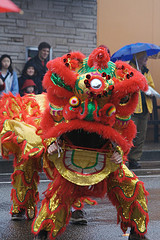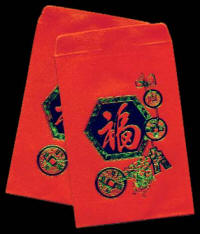Search
Related Articles
Sponsor Ad
Chinese Culture >> Chinese Society Traditions >> Chinese New Year Customs,Traditions
Customs and Traditions of Chinese New Year
By: S Carter
Many interesting and peculiar customs and traditions are an intrinsic part of celebration of the most important festival of the Chinese namely, the Chinese New Year. It is by far an occasion to unite with one's family and dear ones and jubilate in the spirit of togetherness reminiscing and sharing the good old memories of the past year. As the atmosphere is dyed in the festive hue of the season, the color red rules supreme.
 People are garbed in red clothes, children carry money in red
envelopes, even lanterns hung for the purpose of decoration are red in color. It
is so because it is commonly believed that red symbolizes fire which according
to legend can fend off bad luck. Bright red is considered to be an auspicious
color and stands for happiness while gold stands for wealth. The colors black
and white are avoided during this time as they represent mourning.
People are garbed in red clothes, children carry money in red
envelopes, even lanterns hung for the purpose of decoration are red in color. It
is so because it is commonly believed that red symbolizes fire which according
to legend can fend off bad luck. Bright red is considered to be an auspicious
color and stands for happiness while gold stands for wealth. The colors black
and white are avoided during this time as they represent mourning.
There are particular flowers and fruits which are also strongly associated with the celebration of Chinese New Year as each of them radiate their good influence in the life of the people. The Spring Festival that begins one week before the arrival of Chinese New Year will start on 11th of February, 2007. On the occasion of this festival, there is the practice of offering sacrifice to the Kitchen God (Zaowang) who is considered to be the guardian of the family hearth. He is the God sent from heaven to take charge of family affairs and who prepares a report on the past deeds of the family to report the same to Heaven and thus needs to be kept in good humor. The sacrifice to this Kitchen God consists of a lotus root-like sticky cake made of a kind of confection, a typical Chinese traditional candy.
The practice of using this sticky cake called Nian Gao is to make sure that it serves the dual purpose of appeasing the appetite of the Kitchen God as well as sticking his mouth so as to prevent him from speaking ill about the family. This tradition is not so much in vogue in the cities, though it is still in rage in some areas of the countryside. Every traditional Chinese home also has the custom of keeping live blooming plants to symbolize rebirth and new growth. There is also the tradition of welcoming guests with sweet treats and that has led to the evolution of serving a circular tray of colorful candies which is compartmentalized into eight slots to display the same. This "Tray of Togetherness" (Cheun Hup) ensures that all witness a sweet beginning. Another significant custom associated with New Year celebration is to spend the New Year's Eve preparing Chinese dumplings (Jiaozi).
Sometimes even a coin is hid inside the dumpling and whoever gets it is supposedly presumed to enjoy the grace of luck in the coming years. Even a traditional Buddhist vegetarian delight called "Jai" is prepared on the first day of Chinese New Year using eighteen different ingredients as the Chinese believe eighteen to be a lucky number signifying wealth and prosperity. Many interesting and peculiar customs and traditions are an intrinsic part of celebration of the most important festival of the Chinese namely, the Chinese New Year.
It is by far an occasion to unite with one's family and dear ones and jubilate in the spirit of togetherness reminiscing and sharing the good old memories of the past year. As the atmosphere is dyed in the festive hue of the season, the color red rules supreme. People are garbed in red clothes, children carry money in red envelopes, even lanterns hung for the purpose of decoration are red in color. It is so because it is commonly believed that red symbolizes fire which according to legend can fend off bad luck. Bright red is considered to be an auspicious color and stands for happiness while gold stands for wealth. The colors black and white are avoided during this time as they represent mourning.
There are particular flowers and fruits which are also strongly associated with the celebration of Chinese New Year as each of them radiate their good influence in the life of the people. As the preparation for the festivity begins in full swing, the first thing to be borne in mind is to clean the mess, to cast away all that is old and dirty to give a fresh, new look to one's home. So initially 20th of the Twelfth Moon was conventionally set aside for the annual housecleaning with symbolic flowers and fruits used as items of house decor and colorful pictures called Nian Hua placed on the walls to commemorate the Chinese New Year. Socializing is of utmost importance during this time, no wonder people feel cheerful and excited as they indulge in various customs associated with the Chinese New Year.
The first week of Chinese New Year is of extreme importance as families gather around the table and savor a royal feast cooked for the occasion. All the family members usually assemble to share a family meal on New Year's Eve. If a family member couldn't partake in the grand feasting, his presence is usually symbolized by placing an empty seat at the banquet. It has almost become mandatory to prepare food before the New-Year's Day, so that sharp instruments like knives and scissors could be put away to avoid the 'cutting' effect of these on something as rare as luck on the event of New Year. The elaborate feast that is prepared is also a way to show respect and pay tribute to the departed souls.
 Among various peculiar customs, 'Hon Bao' is one such,
whereby married couples give money-filled red envelopes to children and single
adults on New Year's Day. On New Year's Day little children are gifted Red
Lai-See Envelopes which are good luck money wrapped in little red envelopes. It
is also customary to wish family and friends "Gung Hay Fat Choy" with these red
envelopes. Bursting of fireworks as a means to welcome the New Year has seen it
genesis in an ancient belief whereby the Chinese people would light bamboo
stalks whose crackling flames was believed to frighten the evil spirits.
Among various peculiar customs, 'Hon Bao' is one such,
whereby married couples give money-filled red envelopes to children and single
adults on New Year's Day. On New Year's Day little children are gifted Red
Lai-See Envelopes which are good luck money wrapped in little red envelopes. It
is also customary to wish family and friends "Gung Hay Fat Choy" with these red
envelopes. Bursting of fireworks as a means to welcome the New Year has seen it
genesis in an ancient belief whereby the Chinese people would light bamboo
stalks whose crackling flames was believed to frighten the evil spirits.
The seventh day of the New Year was called "Everybody's Birthday" as everyone was considered one year older on that date as in traditional China individual birthdays were not as important as the New Year's Date so people conventionally added one year to their age on the New Year's Day instead of on their birthday. In China there was a prevalent custom of putting paintings of the Gate Gods on the gates during the Chinese New Year. The word "Fook" or fortune usually written by a brush on a diamond piece of red paper is often displayed in many homes and stores. 'Spring Couplets' is yet another rite associated with Chinese New Year.
They are traditionally couplets in Classical Chinese language written with black ink on a red paper. They are hung in stores in the month before the New Year's Day. They are means to greet each other and forecast one's fortune for the coming year or even adapted to suit a situation. The evening of festivity comes to an end with the famous "Festival of Lanterns" or commonly hailed as the Shang Yuan Festival. It is also sometimes called the Little New Year for a series of jubilation that begins with the Chinese New Year has its grand finale with this festival. During this festival children go out at night carrying brightly lit colorful lanterns as these are considered to be symbolic of hope and good luck. "Lantern Festival" is also celebrated by the custom of eating 'tang yuan', small dumplings made out of glutinous rice flour and eating of which reflects family bond. China with its rich culture and heritage has many unique customs and traditions which adds spice to this all important festival of the Chinese New Year and makes the Orient world seem all the more intriguing and mystical.
About the Author
Sean Carter writes on events and holidays celebrated round the globe - Chinese New Year, Christmas, Rosh-Hashanah, Diwali and many more . He is a writer with special interest in ecard industry. He is an active blogger and contributes to Chinese New Year Blog
